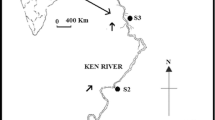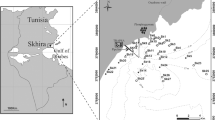Abstract
Over two years after the original creation of a sand excavation pit 8 km off the Louisiana coast, benthic macrofauna communities and sedimentary characteristics are still effected. Macrofaunal communities inside the pit had lower abundance, biomass, and diversity than communities outside the pit. This difference, however, was only significant with some of the stations outside the pit. Results from multi-dimensional scaling and cluster analysis showed that macrofaunal communities were less than 32% similar inside the pit to communities outside the pit. The polychaete Mediomastus ambiseta was the most abundant species outside the excavation pit, but the species was only counted once inside the pit. The most dominant species, which made up over 90% of organisms inside the pit, was the pioneer polychaete Paraprionospio pinnata. Only three species were found at each station inside the pit as opposed to 9–27 species at stations outside the pit. All species inside the pit were also found outside the pit; thus, change was due to a loss of species rather than replacement by different species. Sediment inside the pit contained more silt and clay; however, no difference in water quality was detected compared with outside the pit. Hurricanes Katrina and Rita passed near the dredge pit in 2005 and could have effected sediment transport in the region. Because the macrofaunal community inside the pit has not recovered within 38 months, it is likely that it will require more time before it resembles the surrounding conditions.




Similar content being viewed by others
References
Applebaum S, Montagna PA, Ritter C (2005) Status and trends of dissolved oxygen in Corpus Christi Bay, Texas, U.S.A. Environmental Monitoring and Assessment 107:297–311
Baird and Associates Ltd (2005) Examination of the Physical and Biological Implications of Using Buried Channel Deposits and Other non Topographic Offshore Features as Beach Nourishment Material, Volume 1 - Technical Proposal. Minerals Management Service
Balthis WL, Hyland JL, Bearden DW (2006) Ecosystem responses to extreme natural events: Impacts of three sequential hurricanes in Fall 1999 on sediment quality and condition of benthic fauna in the Neuse River Estuary, North Carolina. Environmental Monitoring and Assessment 119:367–389
Byrnes MR, Hammer RM, Thibaut TD, Snyder DB (2004) Physical and biological effects of sand mining offshore Alabama,U.S.A. Journal of Coastal Research 20(1):6–24
Campbell T, Benedet L, Finkl CW (2005) Regional strategies for coastal restoration along the Louisiana Chenier Plain. Journal of Coastal Research 44:268–283
Clarke KR, Ainsworth M (1993) A method of linking multivariate community structure to environmental variables. Marine Ecology Progress Series 92:205–219
Clarke, KR, Gorley RN (2006) PRIMER v6: User Manual / Tutorial. PRIMER-E: Plymouth, United Kingdom
Clarke, KR, Warwick RM (2001) Change in Marine Communities: An Approach to Statistical Analysis and Interpretation. 2nd Ed. PRIMER-E: Plymouth, United Kingdom
Finkl CW, Khalil SM (2005) Offshore Exploration for Sand Sources: General Guidelines and Procedural Strategies along Deltaic Coasts. Journal of Coastal Research 44:203–233
Folk RL (1964) Petrology of Sedimentary Rocks. The University of Texas, Austin. Texas
Gaston GR (1985) Effects of hypoxia on macrobenthos of the Inner Shelf of Cameron, Louisiana. Estuarine Coastal Shelf Science 20:603–613
Grassle JF, Grassle JP (1974) Opportunistic life histories and genetic systems in marine benthic polychaetes. Journal of Marine Research 32(2):253–284
Harper DE, McKinney LD, Salzer RR, Case RJ (1981) The occurrence of hypoxic bottom water off the Upper Texas Coast and its effects on the benthic biota. Contributions of Marine Science 24:53–79
Hill MO (1973) Diversity and evenness: a unifying notation and its consequences. Ecology 54:427–432
Hilton MJ (1994) Applying the principle of sustainability to coastal sand mining: The case of Pakiri-Mangawhai Beach, New Zealand. Environmental Management 18(6):815–829
Johnnston SA Jr (1981) Estuarine dredge and fill activities: A review of impacts. Environmental Management 5(5):427–440
Jutte PC, Van Dolah RF, Gayes PT (2002) Recovery of Benthic Communities Following Offshore Dredging, Myrtle Beach, South Carolina. Shore & Beach 70(3):25–30
Kennicutt MC II, Schroeder WW, Brooks JM (1995) Temporal and spatial variations in sediment characteristics on the Mississippi-Alabama continental shelf. Continental Shelf Research 15(1):1–18
Lu L, Wu RSS (2000) An experimental study on recolonization and succession of marine macrobenthos in defaunated sediment. Marine Biology 136(2):291–302
Ludwig JA, Reynolds JF (1988) Statistical Ecology: a Primer on Methods and Computing. John Wiley and Sons, New York, p. 368
Mannino A, Montagna PA (1997) Small-scale spatial variation of macrobenthic community structure. Estuaries 20(1):159–173
Montagna PA, Kalke RD (1992) The effect of freshwater inflow on meiofaunal and macrofaunal populations in the Guadalupe and Nueces Estuaries, Texas. Estuaries 15(3):307–326
Montagna PA, Kalke RD, Ritter C (2002) Effect of restored freshwater inflow on macrofauna and meiofauna in upper Rincon Bayou, Texas, USA. Estuaries 25(6B):1436–1447
Montagna PA, Ritter C (2006) Direct and indirect effects of hypoxia on benthos in Corpus Christi Bay, Texas, U.S.A. Journal of Experimental Marine Biology and Ecology 330(1):119–131
Nairn R, Johnson JA, Hardin D, Michel J (2004) A biological and physical monitoring program to evaluate long-term impacts from sand dredging operations in the United States outer continental shelf. Journal of Coastal Research 20(1):126–137
Nairn, RB, Lu Q, Drucker BS (2006) Evolution of dredged pits offshore Louisiana and buffers around seabed infrastructure. Proceedings of the 30th International Conference on Coastal Engineering 3578–3590
Nairn, RB, Lu Q, Langendyk SK, Montagna PA, Powers SP (2007) Examination of the Physical and Biological Implications of Using Buried Channel Deposits and other Non-Topographic Offshore Features as Beach Nourishment Material. U.S. Dept. of the Interior, Minerals Management Service. OCS Study MMS 2007–048
Palmer TA, Montagna PA, Kalke RD (2002) Downstream effects of restored freshwater inflow to Rincon Bayou, Nueces Delta, Texas, USA. Estuaries 25(6B):1448–1456
Palmer TA (2006) Initial Effects of Opening Packery Channel on Estuarine Macrofauna in Corpus Christi Bay, Texas. Masters Thesis. University of Texas at Austin
Pearson TH, Rosenberg R (1978) Macrobenthic succession in relation to organic enrichment and pollution of the marine environment. Oceanography and Marine Biology. An Annual Review 16:229–311
Penland S, Connor PF Jr, Beall A, Fearnley S, Williams SJ (2005) Changes in Louisiana’s Shoreline: 1855–2002. Journal of Coastal Research 44:7–39
Peterson CH (1985) Patterns of lagoonal bivalve mortality after heavy sedimentation and their paleoecological significance. Paleobiology 11(2):139–153
Pokryfki L, Randall RE (1987) Nearshore hypoxia in the bottom water of the northwestern Gulf of Mexico from 1981 to 1984. Marine Environmental Research 22(1):75–90
Rabalais NN, Turner RE, Wiseman WJ (2002)Gulf of Mexico hypoxia, A.K.A. “The dead zone” Annual Review of Ecology and Systematics 33:235–263
Renaud M (1986) Hypoxia in Louisiana coastal waters during 1983: implications for fisheries. Fishery Bulletin 84:19–26
Rhoads DC (1974) Organism-Sediment Relations on the Muddy Sea Floor. Oceanography and Marine Biology. An Annual Review 12:263–300
Rhoads DC, McCall PL, Yingst JY (1978) Disturbance and production on the estuarine seafloor. American Scientist 66(5):577–586
Ritter C, Montagna PA (1999) Seasonal hypoxia and models of benthic response in a Texas bay. Estuaries 22(1):7–20
Ritter C, Montagna PA, Applebaum S (2005) Short-term succession dynamics of macrobenthos in a salinity-stressed estuary. Journal of Experimental Marine Biology and Ecology 323(1):57–69
SAS Institute Inc (1999) SAS/STAT User’s Guide: Version 8. SAS Institute Inc, Cary, North Carolina. p. 3809
Thistle D (1981) Natural physical disturbances and communities of marine soft bottoms. Marine Ecology Progress Series 6(2):223–228
Turner RE, Baustian JJ, Swenson EM, Spicer JS (2006) Wetland sedimentation from Hurricanes Katrina and Rita. Science 314(5798):449–452
USGS (United States Geological Survey) (2005) http://www.coastal.er.usgs.gov/hurricanes/rita/index.html Accessed February 2007
Work PA, Fehrenbacher F, Voulgaris G (2004) Nearshore impacts of dredging for beach nourishment. Journal of Waterway Port Coastal and Ocean Engineering 130(6):303–311
Young DK, Rhoads DC (1971) Animal-sediment relations in Cape Cod Bay, Massachusetts. I. A transect study. Marine Biology 11(3):242–254
Acknowledgments
The authors would like to thank Phil Hanley, Chris Fuller, Lilo Burda, and Anne Williams for sample collection; Larry Hyde and Rick Kalke for providing sampling equipment and assistance in macrofauna identification; April Gossmann for carrying out sediment analysis; and Carrol Simanek for data management. This project was funded via a subcontract to the University of Texas Marine Science Institute (# 10964) under contract number 1435-01-05-RP−39150 between the Minerals Management Service (MMS) and Baird and Associates.
Author information
Authors and Affiliations
Corresponding author
Rights and permissions
About this article
Cite this article
Palmer, T.A., Montagna, P.A. & Nairn, R.B. The Effects of a Dredge Excavation Pit on Benthic Macrofauna in Offshore Louisiana. Environmental Management 41, 573–583 (2008). https://doi.org/10.1007/s00267-007-9063-5
Published:
Issue Date:
DOI: https://doi.org/10.1007/s00267-007-9063-5




